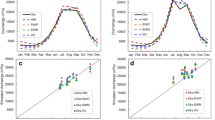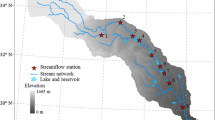Abstract
Individual impacts of climate change, land use/coverage change, the regulation of water reservoir and water use to intra-annual distribution of streamflow of the Dongjiang River basin, South China, are quantitatively separated. Data on precipitation, streamflow, regulation of water reservoirs, and water use are used in the analysis. Changes in the concentration degree and non-uniformity coefficient of intra-annual distribution of streamflow over time scales from daily to monthly are evaluated. Trend and change point analyses are applied to determine characteristics of intra-annual distribution of streamflow. By comparison with the difference among region precipitation, naturalized streamflow and observed streamflow, the contribution of main impact factors to the intra-annual distribution of streamflow are quantified. Results demonstrate the non-uniformity coefficient decreases with a negative logarithmic linear function of the time scale. Change points of the concentration degree and non-uniformity coefficient occurred in 1973 exhibited a significant downward trend. In the period posterior to the change point the former and the latter decrease approximately by 15–34 % and by 29–40 %, respectively. The decrease in concentration degree and non-uniformity coefficient is due to the regulation of water reservoirs and land use/cover change; while the increase is the result of water use and climate change. The individual contributions to the impact on the intra-annual distribution of streamflow from regulation of water reservoirs, land use/cover change, water use, and climate change are approximately −33.5, −9.0, 4.5 and 1.0 %. It is observed that the impacts of the regulations of the Xinfengjiang, Fengshuba, and Baipenzhu reservoirs account for −21, −10, and −2 %, respectively. There is an increasing tendency in the impacts of land use/cover change and water use in the past 30 years.









Similar content being viewed by others
References
Botter G, Zanardo S, Porporato A, Rodriguez-Iturbe I, Rinaldo A (2008) Ecohydrological model of flow duration curves and annual minima. Water Resour Res 44(8):W08418. doi:10.1029/2008WR006814
Botter G, Basso S, Porporato A, Rodriguez-Iturbe I, Rinaldo A (2010) Natural streamflow regime alterations: damming of the Piave River Basin, Italy. Water Resour Res 46(6):W06522. doi:10.1029/2009WR008523
Castellarin A, Vogel RM, Brath A (2004) A stochastic index flow model of flow duration curves. Water Resour Res 40(3):W03104. doi:10.1029/2003WR002524
Chen YD (2001) Sustainable development and management of water resources for urban water supply in Hong Kong. Water Int 26(1):119–128. doi:10.1080/02508060108686891
Chen YD, Huang GR, Shao QX, Xu CY (2006) Regional analysis of low flow using L-moments for Dongjiang Basin, South China. Hydrol Sci J 51(6):1051–1064. doi:10.1623/hysj.51.6.1051
Chen YD, Tao Y, Xu CY, Zhang Q, Chen XH, Hao ZC (2010) Hydrologic alteration along the Middle and Upper East River (Dongjiang) Basin, South China: a visually enhanced mining on the results of RVA method. Stoch Env Res Risk A 24(1):9–18. doi:10.1007/s00477-008-0294-7
Chen L, Singh VP, Guo SL, Fang B, Liu P (2012) A new method for identification of flood seasons using directional statistics. Hydrol Sci J 58(1):1–13. doi:10.1080/02626667.2012.743661
Farahani MA, Khalili D (2013) Seasonality characteristics and spatio-temporal trends of 7-day low flows in a large, semi-arid watershed. Water Resour Manag 27(14):4897–4911. doi:10.1007/s11269-013-0445-6
Feng GZ, Li Y, Li C (2000) Quantification of non-uniformity in annual distribution of stream flows. Acta Univ Agric 28(2):50–53, in Chinese
Furat A, Al-Faraj M, Scholz M (2014) Incorporation of the flow duration curve method within digital filtering algorithms to estimate the base flow contribution to total runoff. Water Resour Manag 28(15):5477–5489. doi:10.1007/s11269-014-0816-7
Hannah DM, Smith BPG, Gurnell AM, McGregor GR (2000) An approach to hydrograph classification. Hydrol Process 14(2):317–338. doi:10.1002/(SICI)1099-1085(20000215)14:2<317::AID-HYP929>3.0.CO;2-T
Hao Z, Singh VP (2011) Single-site monthly streamflow simulation using entropy theory. Water Resour Res 47(9):W09528. doi:10.1029/2010WR010208
Hao Z, Singh VP (2012) Entropy-copula method for single-site monthly streamflow simulation. Water Resour Res 48(6):W06604. doi:10.1029/2011WR011419
Hao XM, Chen YN, Xu CC, Li WH (2007) Impacts of climate change and human activities on the surface runoff in the Tarim River Basin over the last fifty years. Water Resour Manag 22(9):1573–1650. doi:10.1007/s11269-007-9218-4
Harris NM, Gurnell AM, Hannah DM, Petts GE (2000) Classification of river regimes: a context for hydroecology. Hydrol Process 14(16–17):2831–2848. doi:10.1002/1099-1085(200011/12)14:16/17<2831::AID-HYP122>3.0.CO;2-O
Jiang SH, Ren LL, Yong B, Singh VP, Yang XL, Yuan F (2011) Quantifying the effects of climate variability and human activities on runoff from the Laohahe basin in northern China using three different method. Hydrol Process 25(16):2492–2505. doi:10.1002/hyp.8002
Jin XL, Xu CY, Zhang Q, Chen YD (2009) Regionalization study of a conceptual hydrological model in Dongjiang basin, South China. Quat Int 208(1–2):129–137. doi:10.1016/j.quaint.2008.08.006
Leahy PG, Kiely G (2011) Short duration rainfall extremes in Ireland: influenceof climatic variability. Water Resour Manag 25:987–1003. doi:10.1007/s11269-010-9737-2
Li XM, Jiang FQ, Lia LH, Wang GG (2011) Spatial and temporal variability of precipitation concentration index, concentration degree and concentration period in Xinjiang, China. Int J Climatol 31:1679–1693. doi:10.1002/joc.2181
Li FP, Zhang GX, Xu YJ (2014) Spatiotemporal variability of climate and streamflow in the Songhua River Basin, northeast China. J Hydrol 514:53–64. doi:10.1016/j.jhydrol.2014.04.010
Liu DD, Chen XH, Lian YQ, Lou ZH (2010) Impacts of climate change and human activities on surface runoff in the Dongjiang River Basin of China. Hydrol Process 24(11):1487–1495. doi:10.1002/hyp.7609
Liucci L, Valigi D, Casadei S (2014) A new application of Flow Duration Curve (FDC) in designing run-of-river power plants. Water Resour Manag 28(3):881–895. doi:10.1007/s11269-014-0523-4
Ma ZM, Kang SZ, Zhang L, Tong L, Su XL (2008) Analysis of impacts of climate variability and human activity on streamflow for a river basin in arid region of northwest China. J Hydrol 352(3–4):239–249. doi:10.1016/j.jhydrol.2007.12.022
Miao CY, Ni JR, Borthwick GLA, Yang L (2011) A preliminary estimate of human and natural constribution to the changes in water discharge and sediment load in the Yellow River. Global Planet Change 76(3–4):196–205. doi:10.1016/j.gloplacha.2011.01.008
Peng DZ, Xu ZX (2010) Simulating the Impact of climate change on streamflow in the Tarim River basin by using a modified semi-distributed monthly water balance model. Hydrol Process 24(2):209–216. doi:10.1002/hyp.7485
Pettitt AN (1979) A non-parametric approach to the change point problem. J Roy Stat Soc Ser C Appl Stat 28(2):126–135. doi:10.2307/2346729
Pettitt AN (1980) A simple cumulative sum type statistic for the change-point problem with zero–one observations. Biometrika 67(1):79–84. doi:10.2307/2335319
Piao SL, Ciais P, Huang Y, Shen ZH, Peng SS, Li JS, Zhou LP, Liu HY, Ma YC, Ding YH, Friedlingstein P, Liu CZ, Tan K, Yu YQ, Zhang TY, Fang JY (2010) The impacts of climate change on water resources and agriculture in China. Nature 467:43–51. doi:10.1038/nature09364
Ren LL, Wang MR, Li CH, Zhang W (2002) Impacts of human activity on river runoff in the northern area of China. J Hydrol 261(1–4):204–217. doi:10.1016/S0022-1694(02)00008-2
Serinaldi F (2009) Assessing the applicability of fractional order statistics for computing confidence intervals for extreme quantiles. J Hydrol 376(3–4):528–541. doi:10.1016/j.jhydrol.2009.07.065
Serinaldi F (2011) Analytical confidence intervals for index flow duration curves. Water Resour Res 47(2):W02542. doi:10.1029/2010WR009408
Shao QX, Zhang L, Chen YD, Singh VP (2009) A new method for modelling flow duration curves and predicting streamflow regimes under altered land-use conditions. Hydrol Sci J 54(3):606–622. doi:10.1623/hysj.54.3.606
Sheng Y, Wang CY (2004) The Mann-Kendall test modified by effective sample size to detect trend in serially correlated hydrological series. Water Resour Manag 18(3):201–218. doi:10.1023/B:WARM.0000043140.61082.60
Singh VP, Cui HJ, Byrd AR (2014) Derivation of rating curve by the Tsallis entropy. J Hydrol 513:342–352. doi:10.1016/j.jhydrol.2014.03.061
Siriwardena L, Finlayson BL, McMahon TA (2006) The impact of land use change on catchment hydrology in large catchment: the Comet River, central Queensland, Australia. J Hydrol 326(1–4):199–214. doi:10.1016/j.jhydrol.2005.10.030
Smakhtin VY (2001) Low flow hydrology: a review. J Hydrol 240(3–4):147–186. doi:10.1016/S0022-1694(00)00340-1
St. Jacques JM, Sauchyn DJ, Zhao Y (2010) Northern Rocky Mountain streamflow records: global warming trends, human impacts or natural variability? Geophys Res Let 37(6):L06407. doi:10.1029/2009GL042045
Tu XJ, Zhang Q, Singh VP, Chen XH, Liu CL, Wang SB (2012) Space-time changes in hydrological processes in response to human activities and climatic change in the south China. Stoch Env Res Risk A 26(6):823–834. doi:10.1007/s00477-011-0516-2
Wang JX, Zhang JY, Yan L, Zhang SL (2008) Variation trends of runoffs seasonal distribution of the six larger basins in China over the past 50 years. Adv Water Sci 19(5):656–661, in Chinese
Wang GS, Xia J, Chen J (2009) Quantification of effects of climate variations and human activities on runoff by a monthly water balance model: a case study of the Chaobai River Basin in Northern China. Water Resour Res 45(7):W00A11. doi:10.1029/2007WR006768
Wang JH, Hong Y, Gourley J, Adhikari P, Li L, Su FG (2010) Quantitative assessment of climate change and human impacts on long-term hydrologic response: a case study in sub-basin of the Yellow River, China. Int J Climatol 30(14):2130–2137. doi:10.1002/joc.2023
Wang WG, Shao QX, Yang T, Peng SZ, Xing WQ, Sun FC, Luo YF (2013) Quantitative assessment of the impact of climate variability and human activities on runoff changes: a case study in four catchments of the Haihe River basin, China. Hydrol Process 27(8):1158–1174. doi:10.1002/hyp.9299
Wong JS, Zhang Q, Chen YD (2010) Statistical modeling of daily urban water consumption in Hong Kong: trend, changing patterns, and forecast. Water Resour Res 46(3):W03506. doi:10.1029/2009WR008147
Xie ZQ, Du Y, Jiang AJ, Ding YG (2005) Climatic trends of different intensity heavy precipitation events concentration in China. J Geog Sci 15(4):459–465, in Chinese
Zhang LJ, Qian YF (2003) Annual distribution features of precipitation in China and their interannual variations. Acta Meteor Sin 17(2):146–63, in Chinese
Zhang Q, Xu CY, Yu ZG, Liu CL, Chen YD (2009) Multifractal analysis of streamflow records of the East River basin (Pearl River). Chin Phys A 388(6):927–934. doi:10.1016/j.physa.2008.11.025
Zhang Q, Jiang T, Chen YD, Chen XH (2010) Changing properties of hydrological extremes in south China: natural variations or human influences? Hydrol Process 24(11):1421–1432. doi:10.1002/hyp.7599
Zhang Q, Singh VP, Li K, Li JF (2014) Trend, periodicity and abrupt change in streamflow of the East River, the Pearl River Basin. Hydrol Process 28(2):305–314. doi:10.1002/hyp.9576
Zhao GJ, Hörmann G, Fohrer N, Zhang ZX, Zhai JQ (2010) Streamflow trends and climate variability impacts in Poyang Lake Basin, China. Water Resour Manag 24(4):689–706. doi:10.1007/s11269-009-9465-7
Zheng HX, Liu CM (2003) Changes of annual runoff distribution in the headwater of the Yellow River Basin. Prog Geogr 22(6):585–590, in Chinese
Zheng HX, Zhang L, Zhu RR, Liu CM, Sato Y, Fukushima Y (2009) Responses of streamflow to climate and land surface change in the headwaters of the Yellow River Basin. Water Resour Res 45(7):W00A19. doi:10.1029/ 2007WR006665
Zhou Y, Zhang Q, Li K, Chen XH (2012) Hydrological effects of water reservoirs on hydrological processes in the East River, China) basin: complexity evaluations based on the multi-scale entropy analysis. Hydrol Process 26(21):3253–3262. doi:10.1002/hyp.8406
Zuo DP, Xu ZX, Wu W, Zhao J, Zhao FF (2014) Identification of streamflow response to climate change and human activities in the Wei River Basin, China. Water Resour Manag 28:833–851. doi:10.1007/s11269-014-0519-0
Acknowledgments
Supported by the Open Research Fund of State Key Laboratory of Simulation and Regulation of Water Cycle in River Basin (China Institute of Water Resources and Hydropower Research, Grant NO: IWHR-SKL-201314), the State National Natural Science Foundation of China (Grant NO: 51479217, 51210013, 51309104), and the Scholarship Fund of the China Scholarship Council (Grant NO: 201308440054), are gratefully acknowledged.
Author information
Authors and Affiliations
Corresponding author
Rights and permissions
About this article
Cite this article
Tu, X., Singh, V.P., Chen, X. et al. Intra-annual Distribution of Streamflow and Individual Impacts of Climate Change and Human Activities in the Dongijang River Basin, China. Water Resour Manage 29, 2677–2695 (2015). https://doi.org/10.1007/s11269-015-0963-5
Received:
Accepted:
Published:
Issue Date:
DOI: https://doi.org/10.1007/s11269-015-0963-5




